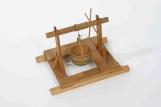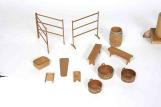14
HOUSEHOLD BASKETSContainers of all sizes and shapes were used by the early Canadian pioneer and settler to hold a variety of objects. Often Indian baskets were used which tended to be hardy and long lasting. A great example of this craft is reflected in McCrea's reproduction of a laundry basket with the rolled bark edging securing the edges. Smaller baskets were used to store sewing supplies and other household objects while baskets were obtained with covers to keep the flies out of stored foods.
16
ROPE BEDA lovely four poster bed with turned posts and shaped headboard and footboard would have been the pride of a pioneer household. Ropes were strung tautly to hold the mattress, which might be filled with fresh straw each year or if the family had ducks, with feathers. Many of these beds are now sought eagerly by collectors as they reflect early Canadian furniture making and craftsmanship.
18
WINDLASSOne of the first necessities that the pioneer family had to be concerned about was a supply of fresh water. Springs and streams were plentiful and fulfilled the initial need however wells had to be dug. Many shallow wells were dug by hand and lined with stones and many of these are still in use today. The windlass at the left of the picture was used for hauling up buckets of earth and then taking down the stones to the men in the well.
20
OAKEN BUCKET WELLThe oaken bucket style of well was generally used for shallower wells where the length of chain was shorter. A roller was placed in the upright poles and a rope and bucket placed on the roller. This would be the first type of water retrieval of the early pioneer.
22
WINDING WELLThis type of well was used for deeper wells where it was necessary to "crank" up a fairly long chain that held the bucket. The well had a small roof to discourage objects such as leaves falling into the well.
24
PINE BENCH AND PAILSA rain barrel containing precious drinking water stands near the door with every detail accurately reproduced and on the pine bench are a hand basin and a pail.
Until wells were dug and in operation, the pioneer family relied on soft rain water for washing and drinking.
The pioneer kitchen also contains the small touches that both decorate and are useful such as the braided rugs and the candlestick on the table.
26
LAUNDRY EQUIPMENTPrimitive by modern standards, the laundry was undertaken with muscle power.
The hollowed out log was used to catch the rainwater used for washing. Wooden pails and buckets and two types of wash boards were carefully replicated as well as the wooden clothes "horses" on which the clothes were hung to dry.
Soap had to be made by the pioneer
Settlers cleared much forest land in order to turn the land into productive fields. Pine and cedar were used for lumber, but maple, oak and other hardwoods were used primarily for fuel. The resultant ash contained a chemical called potash, which was valuable in the making of soap. The ash was placed in a large hollow basswood log (later a vat with a perforated bottom), and kept wet with water. The water passing slowly through the ashes leached out a chemical called lye. The lye was then put in a soap kettle and kitchen fats and bones were added to make a 'soft soap'. This was used to scrub wooden floors, which made them white, and for washing clothes.
Lye could also be boiled until all water evaporated. This formed a cake called potash that was sold for cash to make soaps and other products. Hard soap was also made for washing of clothes and the family. When salt was added a layer formed on the top that was firm enough to cut into cakes and put on a board to dry.






